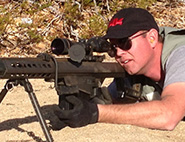How to Sight your Gun or Rifle
This article is written assuming that you have rear adjustable sights on your pistol. However if your fixed sight is inserted into a dovetail notch, it can still be adjusted for windage (left or right) using a sight adjustment tool or a brass drift kit and the method below. First thing is first, lets get the obvious out of the way. Inspect the firearm to make sure it is assembled correctly and will function properly. Make sure it is properly lubricated where lubrication should be. Make sure you are using the proper ammo. The caliber should be clearly marked on the barrel. Step 1: Step 2: Using your solid rest and best sniper skills, try to minimize human contact with a rifle. For pistols I use a flat table and a low chair. I place my dominant arm (trigger finger arm) flat against the table, thumbs forward using a target grip. Again the arm flat on the table helps to minimize unwanted movement. Shoot about 3 to 5 rounds at the bullseye and have a look at the grouping. Whether on or off the bullseye, the group should be pretty tight. If not, you need to put more ammo through the gun, you are flinching, or your rest sucks. Determine the cause and make necessary corrections. Step 3: For rifle or a scope, this will be no different. Adjust the cross-hairs in the direction you want the bullet to go. If you want the bullet hit higher on the paper, adjust the elevation turret (on top) to the direction that say up. If you want the bullet to move right, adjust the windage turret (on side) in the direction that says right. Repeat until you achieve acceptable results. Don't obsess just yet, we will be adjusting again. Step 4: Step 5: For my pistols, I like a 25 yard zero. Most pistols will shoot pretty flat out to about30 - 35 yards so this seems to work well for me. I would now move my target to 25 yards and adjust my sights accordingly. When sighting a scoped rifle, I will now move the target out to 200 yards and turn turrets till zero. With a non-magnified Red Dot that can be difficult. So when Zeroing a Red Dot optic I simply re-check the sights @50 yards and call it good. In theory it is the same thing, the 50 yard zero will meet the 200 yard zero, just easier to accomplish without magnification. There are many excellent charts and calculators that can be found online to help you choose a zero that works for you. I have listed a few of them below. www.hornady.com Shoot safely, have fun.
|
| Copyright 2023 | Ballistics101.com | All rights reserved |
